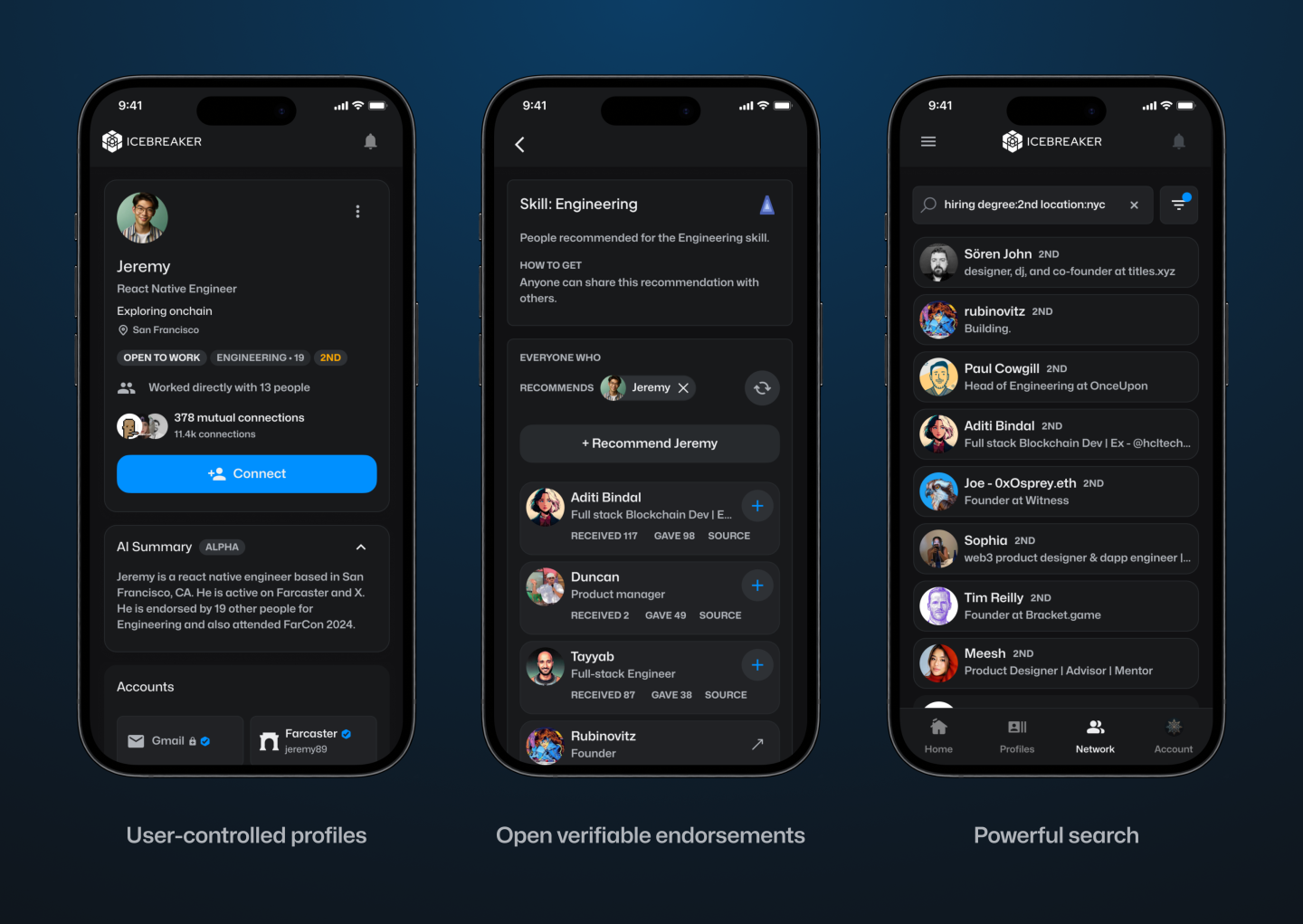News
Definition, Explanation, Pros & Cons

Paid non-client promotion: Affiliate links for the products on this page are from partners that compensate us (see our advertiser disclosure with our list of partners for more details). However, our opinions are our own. See how we rate investing products to write unbiased product reviews.
- Blockchain is a decentralized, digital database that stores transactions and other forms of data.
- Key blockchain features include immutable records, distributed ledger security, and smart contracts.
- Blockchain has many other uses outside of cryptocurrencies.
It’s almost impossible to say “cryptocurrency” without mentioning blockchain technology. A blockchain is a digital, public ledger that securely stores segments of data through a self-managing, peer-to-peer (P2P) network of computers. And some of its key components include irreversible records (i.e., unchangeable blocks of data), decentralized transactions, and smart contracts.
Decentralized digital assets like crypto and stablecoins use blockchain technology for buying and selling assets. Centralized banking digital currencies (CBDCs) are centralized currencies and don’t use a blockchain.
Here’s how blockchains work — along with a closer look at their pros, cons, and potential applications.
Blockchain key terms:
- Nodes: Strong computers connected to a blockchain network in order to process, maintain, and verify crypto transactions. Nodes rely on consensus algorithms and need to be connected to an open-source operating system. Types of blockchain nodes include mining nodes, full blockchain nodes, master nodes, and light nodes. For example, bitcoin uses light nodes to save storage space that only downloads key data.
- Decentralized currency: Currencies, such as cryptocurrencies and stablecoins, that are not issued by a government or financial institution in order to cut out banks as the “middlemen” of trading. Instead, decentralized currencies use peer-to-peer trading and a general system of trust.
- Digital currency: Also referred to as electronic money or digital money, is a form of currency without a physical equivalent and can only be accessed digitally. Examples of digital currencies includes cryptocurrencies, stablecoins, and central bank digital currencies (CBDCs).
- Peer-to-peer networks: Transactions are completed directly between merchants and consumers. It eliminates the need for bank loans or money borrowing. Some prominent examples of P2P networks include file-sharing (sites that allow users to share and download content), media streaming (such as YouTube, which allows users to upload content for viewers to access), and crypto trading platforms.
What is a blockchain?
A blockchain is a digital database that stores “blocks” of data in chronological order. These blocks are linked together on what’s known as the “chain,” and unlike traditional databases that utilize a third party or intermediary, a blockchain is completely decentralized.
This means that no third parties can monitor or interfere with transactions. The blockchain system is basically self-regulating, thanks to a P2P computer network of nodes (i.e., individual computers) that verify all new data and distribute cross-network copies of the blockchain to keep it secure.
“Blockchains are made of, well, blocks,” explains Lorien Gabel, co-founder and CEO of Figment.io. “Each block contains a timestamp, transaction data, and a mathematical function from the previous block. Computers that mine blocks or run validating nodes that sign blocks will include that mathematical function — called a cryptographic hash — from the previous block into the current block to form a chain.”
Quick tip: Blockchain is not to be confused with bitcoin. Bitcoin transactions wouldn’t be possible without blockchain technology, but the two are completely different. While bitcoin is a tradeable digital currency, blockchain is merely the underlying technology that makes secure transactions possible for bitcoin (and other digital assets).
Wealthfront Investing


Icon of check mark inside a promo stamp
It indicates a confirmed selection.
Perks
Account Minimum
$1 ($500 for automated investing)
Fees
$0 for stock trades. 0.25% for automated investing (0.06% to 0.13% for fund fees)
Pros
-
Check mark icon
A check mark. It indicates a confirmation of your intended interaction.Low annual fee for investment accounts; crypto trust investments available
-
Check mark icon
A check mark. It indicates a confirmation of your intended interaction.Tax-loss harvesting, portfolio lines of credit, 529 college savings plans available
-
Check mark icon
A check mark. It indicates a confirmation of your intended interaction.Cash account
-
Check mark icon
A check mark. It indicates a confirmation of your intended interaction.Mobile app and investing and retirement tools
Cons
-
con icon
Two crossed lines that form an ‘X’.You need at least $100,000 to utilize additional investment strategies
-
con icon
Two crossed lines that form an ‘X’.No human advisor access
Product Details
- Consider it if: You’re balancing several goals and want to streamline your finances.
- Promotion: Fund your first taxable investment account with at least $500 in the first 30 days of account opening and earn a $50 bonus.
How a blockchain works
Cryptocurrencies would essentially be nonexistent without a blockchain. This technology relies on a distributed ledger that keeps a record of all past, present, and future data (e.g., transactions or accounts).
“A blockchain is commonly used to build a distributed ledger,” says Gabel. Ledgers, he added, track accounting transactions and accounts — we can think of it as a database that stores information. “Distributed ledgers don’t have to be on a blockchain to be considered ‘distributed,’ they just have to be shared with other computers on the network.”
But several other features separate blockchain technology from traditional databases controlled by financial institutions. These include immutable, or unchanging, records and smart contracts.
Irreversible transactions
Each transaction that the nodes add to the blockchain is permanent. So once the computer network verifies the data and adds it as a new block, that record is permanent. And this serves much more important purposes beyond simply keeping the system running.
“Transactions are irreversible, permanently recorded, and available for everyone to see. It’s challenging and complicated for any one actor to change or falsify data recorded on a ledger,” explains Gabel.
In order to change the data on the ledger and have the modified chain become the majority chain, someone would have to both alter their duplicate of the ledger while adjusting at least 51% of other users’ copies of the database. Therefore, the immutable records component makes it extremely difficult to hack the system.
Smart contracts
“[A smart contract] is a self-executing contract with the terms of the agreement directly written into lines of code on the blockchain,” Gabel explains. This allows them to execute once the terms are met.
But as for the blockchain process, here’s how it works: Whenever a new transaction takes place (e.g., a bitcoin or ether buy order), that data is sent to a network of computers (nodes) that solve math equations to validate the transaction.
If the transaction is rejected, it won’t show up on the blockchain. But if it’s confirmed, the nodes will add the data as a new block on the ledger, chaining it to the prior blocks (and the ones that follow) to maintain the chain’s security. Once this step is done the transaction is complete.
The blockchain process can be broken down into simple steps.
Alyssa Powell/Insider
What is a blockchain used for?
Cryptocurrency is likely the first thought many people have when it comes to blockchain, but this technology has many other uses:
- Banking and finance: Blockchain has many uses for money transfers, especially for fiat currencies (e.g., USD, EUR, or JPY) that individuals typically exchange through financial institutions like banks or payment services.
- Cryptocurrency: This is perhaps one of the most well-known uses of blockchain technology. The blockchain stores data for all cryptocurrency exchanges.
- Healthcare: Blockchain has several applications within the medical industry. It can be used to secure medical records, healthcare data, and other related electronic records.
- Records of property: Whether it be property deeds or other assets, this technology can additionally validate property transactions between two parties.
- Voting: Though not currently in effect, the idea of using blockchain to improve the voting process has become a topic of discussion. Arguments in favor urge that it could prevent voter fraud and offer a simpler way of counting votes. Those against it insist that such a system could pose national security concerns.
Quick tip: Since blockchain isn’t a digital currency, you can’t directly invest in it. But you can still gain portfolio exposure by investing in the stocks of blockchain companies or platforms that offer cryptocurrency products.
“Blockchain technology provides a solution to the challenges of storing, managing, and protecting data,” says Gabel. “It provides a useful and secure way of authenticating information, identities, transactions, and more, creating a secure ledger that can be updated in real time.”
Blockchain: Pros and cons
Blockchain has several uses, including cryptocurrency transactions, fiat transfers, and more. However, there are also pros and cons to consider.
There are many perks to blockchain-secured transactions. Its efficiency, security, and lack of intermediaries can make it an ideal option for those looking to safely store a range of data.
However, since there’s no centralized party to govern the database, you can never recover any assets if you lose your private key. This is important to keep in mind if you’d like to take advantage of blockchain-powered transactions.
Insider’s Featured Crypto Apps
Chevron icon
It indicates an expandable section or menu, or sometimes previous / next navigation options.
Chevron icon
It indicates an expandable section or menu, or sometimes previous / next navigation options.
Editor’s Rating
4.14/5
A five pointed star
A five pointed star
A five pointed star
A five pointed star
A five pointed star
Editor’s Rating
4.34/5
A five pointed star
A five pointed star
A five pointed star
A five pointed star
A five pointed star
Building a blockchain
You can create your own blockchain (or build onto/modify an existing blockchain) if you have coding and/or advanced computer knowledge. By building your own blockchain, you can design your own cryptocurrency for others to trade. You’ll be able to choose its purpose, tokenomics, functionality, and legality.
You create a blockchain by:
- Designing your own by scratch: If you’re especially skilled at coding and computers, you may be able to create your blockchain from scratch. You’ll need to establish a secure network, create a functioning algorithm, choose a protocol, follow legal regulations, and make sure your code has strong defenses against hacks and other fraudulent activity.
- Modifying an existing blockchain: A slighter simpler (not necessarily easier) method of creating a blockchain is by modifying an existing chain’s open-sourced code and revising it to your liking. This way you can expand upon already functioning algorithms and possibly even improve functionality.
- Building onto an existing blockchain: This method isn’t necessarily “creating” a blockchain, but instead allows you to design your own cryptocurrency on top of an already existing blockchain, like Ethereum or Binance. It’s easier than the other two methods but also more restrictive.
Creating your own blockchain isn’t recommended for beginner crypto traders or beginner coders. Creating a functioning and secure blockchain is an exceptionally difficult project, and the competition is steep. Only advanced traders and computer experts will be up to the task.
Blockchain technology
Blockchain technology utilizes a P2P network of computers to securely process and store transactions in a digital database. Unlike traditional databases that rely on central authorities, blockchain completely removes the need for intermediaries.
Security is another major component of blockchain technology. Some of its key features — including immutable records and smart contracts — work to keep all data secure.
Overall, blockchain technology has many uses in both the crypto world and beyond, but it’s important to understand how it works before you utilize it.


Rickie Houston
Senior Wealth-Building Reporter
Rickie Houston was a senior wealth-building reporter for Business Insider, tasked with covering brokerage products, investment apps, online advisor services, cryptocurrency exchanges, and other wealth-building financial products.
Before Insider, Rickie worked as a personal finance writer at SmartAsset, focusing on retirement, investing, taxes, and banking topics. He’s contributed to stories published in the Boston Globe, and his work has also been featured in Yahoo News.
He graduated from Boston University, where he contributed as a staff writer and sports editor for Boston University News Service.
Read more
Read less


Tessa Campbell
Investing and Retirement Reporter
Tessa Campbell is an investing and retirement reporter on Business Insider’s personal finance desk. Over two years of personal finance reporting, Tessa has built expertise on a range of financial topics, from the best credit cards to the best retirement savings accounts.ExperienceTessa currently reports on all things investing — deep-diving into complex financial topics, shedding light on lesser-known investment avenues, and uncovering ways readers can work the system to their advantage.As a personal finance expert in her 20s, Tessa is acutely aware of the impacts time and uncertainty have on your investment decisions. While she curates Business Insider’s guide on the best investment apps, she believes that your financial portfolio does not have to be perfect, it just has to exist. A small investment is better than nothing, and the mistakes you make along the way are a necessary part of the learning process.Expertise: Tessa’s expertise includes:
- Credit cards
- Investing apps
- Retirement savings
- Cryptocurrency
- The stock market
- Retail investing
Education: Tessa graduated from Susquehanna University with a creative writing degree and a psychology minor.When she’s not digging into a financial topic, you’ll find Tessa waist-deep in her second cup of coffee. She currently drinks Kitty Town coffee, which blends her love of coffee with her love for her two cats: Keekee and Dumpling. It was a targeted advertisement, and it worked.
Read more
Read less
Top Offers From Our Partners


News
Terra Can’t Catch a Break as Blockchain Gets $6 Million Exploited

The attack, which exploited a vulnerability disclosed in April, drained around 60 million ASTRO tokens, sending the price plummeting.
The Terra blockchain has been exploited for over $6 million, forcing developers to take a momentary break the chain.
Beosin Cyber Security Company reported that the protocol lost 60 million ASTRO tokens, 3.5 million USDC, 500,000 USDT, and 2.7 BTC or $180,000.
Terra developers paused the chain on Wednesday morning to apply an emergency patch that would address the attack. Moments later, a 67% majority of validators upgraded their nodes and resumed block production.
The ASTRO token has plunged as much as 75%. It is now trading at $0.03, a 25% decline on the day. Traders who took advantage of the drop are now on 195%.
The vulnerability that took down the Cosmos-based blockchain was disclosed in April and involved the deployment of a malicious CosmWasm contract. It opened the door to attacks via what is called an “ibc-hooks callback timeout reentrancy vulnerability,” which is used to invoke contracts and enable cross-chain swaps.
Terra 2.0 also suffered a massive drop in total value locked (TVL) in April, shortly after the vulnerability was discovered. It plunged 80% to $6 million from $30 million in TVL and has since lost nearly half of that value, currently sitting at $3.9 million.
The current Earth chain emerged from the rubble as a hard fork after the original blockchain, now called Terra Classic, collapsed in 2022. Terra collapsed after its algorithmic stablecoin (UST) lost its peg, causing a run on deposits. More than $50 billion of UST’s market cap was wiped out in a matter of days.
Terraform Labs, the company behind the blockchain, has been slowly unravelling its legal woes since its mid-2022 crash. Founder Do Kwon awaits sentencing in Montenegro after he and his company were found liable for $40 billion in customer funds in early April.
On June 12, Terraform Labs settled with the SEC for $4.4 billion, for which the company will pay about $3.59 billion plus interest and a $420 million penalty. Meanwhile, Kwon will pay $204.3 million, including $110 million in restitution, interest and an $80 million penalty, a court filing showed.
News
Google and Coinbase Veterans Raise $5M to Build Icebreaker, Blockchain’s Answer to LinkedIn

Icebreaker: Think LinkedIn but on a Blockchain—announced Wednesday that it has secured $5 million in seed funding. CoinFund led the round, with participation from Accomplice, Anagram, and Legion Capital, among others.
The company, which is valued at $21 million, aims to become the world’s first open-source network for professional connections. Its co-founders, Dan Stone and Jack Dillé, come from Google AND Monetary base; Stone was a product manager at the cryptocurrency giant and also the co-creator of Google’s largest multi-identity measurement and marketing platform, while Dillé was a design manager for Google Working area.

The pair founded Icebreaker on the shared belief that the imprint of one’s digital identity (and reputation) should not be owned by a single entity, but rather publicly owned and accessible to all. Frustrated that platforms like LinkedIn To limit how we leverage our connections, Dillé told Fortune he hopes to remove paywalls and credits, which “force us to pay just to browse our network.” Using blockchain technology, Icebreaker lets users transfer their existing professional profile and network into a single, verified channel.
“Imagine clicking the login button and then seeing your entire network on LinkedIn, ChirpingFarcaster and email? Imagine how many introductions could be routed more effectively if you could see the full picture of how you’re connected to someone,” Stone told Fortune.
Users can instantly prove their credentials and provide verifiable endorsements for people in their network. The idea is to create an “open graph of reputation and identity,” according to the founders. They hope to challenge LinkedIn’s closed network that “secures data,” freeing users to search for candidates and opportunities wherever they are online. By building on-chain, the founders note, they will create a public ledger of shared context and trust.
Verified channels are now launched for
Chirping
Online Guide
Wallet
Discord
Telephone
TeleporterYou can find them in Account -> Linked Accounts Italian: https://t.co/mRDyuWW8O2
— Icebreaker (@icebreaker_xyz) April 3, 2024
“Digital networking is increasingly saturated with noise and AI-driven fake personas,” the founders said in a statement. For example: Dillé’s LinkedIn headline reads “CEO of Google,” a small piece of digital performance art to draw attention to unverifiable information on Web2 social networks that can leave both candidates and recruiters vulnerable to false claims.
“Icebreaker was created to enable professionals to seamlessly tap into their existing profiles and networks to surface exceptional people and opportunities, using recent advances in cryptographically verifiable identity,” the company said, adding that the new funding will go towards expanding its team and developing products.
“One of the next significant use cases for cryptocurrency is the development of fundamental social graphs for applications to leverage… We are proud to support Dan, Jack and their team in their mission to bring true professional identity ownership to everyone online,” said CoinFund CIO Alex Felix in a statement.
Learn more about all things cryptocurrency with short, easy-to-read flashcards. Click here to Fortune’s Crash Course in Cryptocurrency.
Fuente
News
Luxembourg proposes updates to blockchain laws | Insights and resources

On July 24, 2024, the Ministry of Finance proposed Blockchain Bill IVwhich will provide greater flexibility and legal certainty for issuers using Distributed Ledger Technology (DLT). The bill will update three of Luxembourg’s financial laws, the Law of 6 April 2013 on dematerialised securitiesTHE Law of 5 April 1993 on the financial sector and the Law of 23 December 1998 establishing a financial sector supervisory commissionThis bill includes the additional option of a supervisory agent role and the inclusion of equity securities in dematerialized form.
DLT and Luxembourg
DLT is increasingly used in the financial and fund management sector in Luxembourg, offering numerous benefits and transforming various aspects of the industry.
Here are some examples:
- Digital Bonds: Luxembourg has seen multiple digital bond issuances via DLT. For example, the European Investment Bank has issued bonds that are registered, transferred and stored via DLT processes. These bonds are governed by Luxembourg law and registered on proprietary DLT platforms.
- Fund Administration: DLT can streamline fund administration processes, offering new opportunities and efficiencies for intermediaries, and can do the following:
- Automate capital calls and distributions using smart contracts,
- Simplify audits and ensure reporting accuracy through transparent and immutable transaction records.
- Warranty Management: Luxembourg-based DLT platforms allow clients to swap ownership of baskets of securities between different collateral pools at precise times.
- Tokenization: DLT is used to tokenize various assets, including real estate and luxury goods, by representing them in a tokenized and fractionalized format on the blockchain. This process can improve the liquidity and accessibility of traditionally illiquid assets.
- Tokenization of investment funds: DLT is being explored for the tokenization of investment funds, which can streamline the supply chain, reduce costs, and enable faster transactions. DLT can automate various elements of the supply chain, reducing the need for reconciliations between entities such as custodians, administrators, and investment managers.
- Issuance, settlement and payment platforms:Market participants are developing trusted networks using DLT technology to serve as a single source of shared truth among participants in financial instrument investment ecosystems.
- Legal framework: Luxembourg has adapted its legal framework to accommodate DLT, recognising the validity and enforceability of DLT-based financial instruments. This includes the following:
- Allow the use of DLT for the issuance of dematerialized securities,
- Recognize DLT for the circulation of securities,
- Enabling financial collateral arrangements on DLT financial instruments.
- Regulatory compliance: DLT can improve transparency in fund share ownership and regulatory compliance, providing fund managers with new opportunities for liquidity management and operational efficiency.
- Financial inclusion: By leveraging DLT, Luxembourg aims to promote greater financial inclusion and participation, potentially creating a more diverse and resilient financial system.
- Governance and ethics:The implementation of DLT can promote higher standards of governance and ethics, contributing to a more sustainable and responsible financial sector.
Luxembourg’s approach to DLT in finance and fund management is characterised by a principle of technology neutrality, recognising that innovative processes and technologies can contribute to improving financial services. This is exemplified by its commitment to creating a compatible legal and regulatory framework.
Short story
Luxembourg has already enacted three major blockchain-related laws, often referred to as Blockchain I, II and III.
Blockchain Law I (2019): This law, passed on March 1, 2019, was one of the first in the EU to recognize blockchain as equivalent to traditional transactions. It allowed the use of DLT for account registration, transfer, and materialization of securities.
Blockchain Law II (2021): Enacted on 22 January 2021, this law strengthened the Luxembourg legal framework on dematerialised securities. It recognised the possibility of using secure electronic registration mechanisms to issue such securities and expanded access for all credit institutions and investment firms.
Blockchain Act III (2023): Also known as Bill 8055, this is the most recent law in the blockchain field and was passed on March 14, 2023. This law has integrated the Luxembourg DLT framework in the following way:
- Update of the Act of 5 August 2005 on provisions relating to financial collateral to enable the use of electronic DLT as collateral on financial instruments registered in securities accounts,
- Implementation of EU Regulation 2022/858 on a pilot scheme for DLT-based market infrastructures (DLT Pilot Regulation),
- Redefining the notion of financial instruments in Law of 5 April 1993 on the financial sector and the Law of 30 May 2018 on financial instruments markets to align with the corresponding European regulations, including MiFID.
The Blockchain III Act strengthened the collateral rules for digital assets and aimed to increase legal certainty by allowing securities accounts on DLT to be pledged, while maintaining the efficient system of the 2005 Act on Financial Collateral Arrangements.
With the Blockchain IV bill, Luxembourg will build on the foundations laid by previous Blockchain laws and aims to consolidate Luxembourg’s position as a leading hub for financial innovation in Europe.
Blockchain Bill IV
The key provisions of the Blockchain IV bill include the following:
- Expanded scope: The bill expands the Luxembourg DLT legal framework to include equity securities in addition to debt securities. This expansion will allow the fund industry and transfer agents to use DLT to manage registers of shares and units, as well as to process fund shares.
- New role of the control agent: The bill introduces the role of a control agent as an alternative to the central account custodian for the issuance of dematerialised securities via DLT. This control agent can be an EU investment firm or a credit institution chosen by the issuer. This new role does not replace the current central account custodian, but, like all other roles, it must be notified to the Commission de Surveillance du Secteur Financier (CSSF), which is designated as the competent supervisory authority. The notification must be submitted two months after the control agent starts its activities.
- Responsibilities of the control agent: The control agent will manage the securities issuance account, verify the consistency between the securities issued and those registered on the DLT network, and supervise the chain of custody of the securities at the account holder and investor level.
- Simplified payment processesThe bill allows issuers to meet payment obligations under securities (such as interest, dividends or repayments) as soon as they have paid the relevant amounts to the paying agent, settlement agent or central account custodian.
- Simplified issuance and reconciliationThe bill simplifies the process of issuing, holding and reconciling dematerialized securities through DLT, eliminating the need for a central custodian to have a second level of custody and allowing securities to be credited directly to the accounts of investors or their delegates.
- Smart Contract Integration:The new processes can be executed using smart contracts with the assistance of the control agent, potentially increasing efficiency and reducing intermediation.
These changes are expected to bring several benefits to the Luxembourg financial sector, including:
- Fund Operations: Greater efficiency and reduced costs by leveraging DLT for the issuance and transfer of fund shares.
- Financial transactions: Greater transparency and security.
- Transparency of the regulatory environment: Increased attractiveness and competitiveness of the Luxembourg financial centre through greater legal clarity and flexibility for issuers and investors using DLT.
- Smart Contracts: Potential for automation of contractual terms, reduction of intermediaries and improvement of transaction traceability through smart contracts.
Blockchain Bill IV is part of Luxembourg’s ongoing strategy to develop a strong digital ecosystem as part of its economy and maintain its status as a leading hub for financial innovation. Luxembourg is positioning itself at the forefront of Europe’s growing digital financial landscape by constantly updating its regulatory framework.
Local regulations, such as Luxembourg law, complement European regulations by providing a more specific legal framework, adapted to local specificities. These local laws, together with European initiatives, aim to improve both the use and the security of projects involving new technologies. They help establish clear standards and promote consumer trust, while promoting innovation and ensuring better protection against potential risks associated with these emerging technologies. Check out our latest posts on these topics and, for more information on this law, blockchain technology and the tokenization mechanism, do not hesitate to contact us.
We are available to discuss any project related to digital finance, cryptocurrencies and disruptive technologies.
This informational piece, which may be considered advertising under the ethics rules of some jurisdictions, is provided with the understanding that it does not constitute the rendering of legal or other professional advice by Goodwin or its attorneys. Past results do not guarantee a similar outcome.
News
New bill pushes Department of Veterans Affairs to examine how blockchain can improve its work

The Department of Veterans Affairs would have to evaluate how blockchain technology could be used to improve benefits and services offered to veterans, according to a legislative proposal introduced Tuesday.
The bill, sponsored by Rep. Nancy Mace, R-S.C., would direct the VA to “conduct a comprehensive study of the feasibility, potential benefits, and risks associated with using distributed ledger technology in various programs and services.”
Distributed ledger technology, including blockchain, is used to protect and track information by storing data across multiple computers and keeping a record of its use.
According to the text of the legislation, which Mace’s office shared exclusively with Nextgov/FCW ahead of its publication, blockchain “could significantly improve benefits allocation, insurance program management, and recordkeeping within the Department of Veterans Affairs.”
“We need to bring the federal government into the 21st century,” Mace said in a statement. “This bill will open the door to research on improving outdated systems that fail our veterans because we owe it to them to use every tool at our disposal to improve their lives.”
Within one year of the law taking effect, the Department of Veterans Affairs will be required to submit a report to the House and Senate Veterans Affairs committees detailing its findings, as well as the benefits and risks identified in using the technology.
The mandatory review is expected to include information on how the department’s use of blockchain could improve the way benefits decisions are administered, improve the management and security of veterans’ personal data, streamline the insurance claims process, and “increase transparency and accountability in service delivery.”
The Department of Veterans Affairs has been studying the potential benefits of using distributed ledger technology, with the department emission a request for information in November 2021 seeking input from contractors on how blockchain could be leveraged, in part, to streamline its supply chains and “secure data sharing between institutions.”
The VA’s National Institute of Artificial Intelligence has also valued the use of blockchain, with three of the use cases tested during the 2021 AI tech sprint focused on examining its capabilities.
Mace previously introduced a May bill that would direct Customs and Border Protection to create a public blockchain platform to store and share data collected at U.S. borders.
Lawmakers also proposed additional measures that would push the Department of Veterans Affairs to consider adopting other modernized technologies to improve veteran services.
Rep. David Valadao, R-Calif., introduced legislation in June that would have directed the department to report to lawmakers on how it plans to expand the use of “certain automation tools” to process veterans’ claims. The House of Representatives Subcommittee on Disability Assistance and Memorial Affairs gave a favorable hearing on the congressman’s bill during a Markup of July 23.
-

 Videos9 months ago
Videos9 months agoCrypto News: Bitcoin, ETH Price, CPI Print, PYTH, WIF & MORE!!
-

 Videos9 months ago
Videos9 months agoCrypto News: Bitcoin Price, ETF, ETH, WIF, HNT & MORE!!
-

 DeFi9 months ago
DeFi9 months agoMetasphere Labs announces follow-up event regarding
-

 Videos9 months ago
Videos9 months agoSolana price potential?! Check out THIS update if you own SOL!!
-

 Videos8 months ago
Videos8 months agoWho Really CONTROLS THE MARKETS!! Her plans REVEALED!!
-

 DeFi6 months ago
DeFi6 months agoPump.Fun Overtakes Ethereum in Daily Revenue: A New Leader in DeFi
-

 News6 months ago
News6 months agoNew bill pushes Department of Veterans Affairs to examine how blockchain can improve its work
-

 DeFi6 months ago
DeFi6 months agoDegens Can Now Create Memecoins From Tweets
-

 News6 months ago
News6 months agoLawmakers, regulators to study impact of blockchain and cryptocurrency in Alabama • Alabama Reflector
-

 Bitcoin6 months ago
Bitcoin6 months ago1 Top Cryptocurrency That Could Surge Over 4,300%, According to This Wall Street Firm
-

 Ethereum8 months ago
Ethereum8 months agoComment deux frères auraient dérobé 25 millions de dollars lors d’un braquage d’Ethereum de 12 secondes • The Register
-

 Videos8 months ago
Videos8 months agoCryptocurrency News: BTC Rally, ETH, SOL, FTM, USDT Recover & MORE!


 ASTRO Price
ASTRO Price



